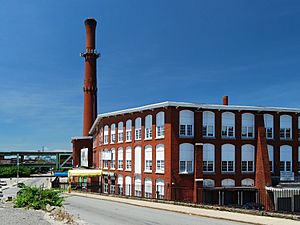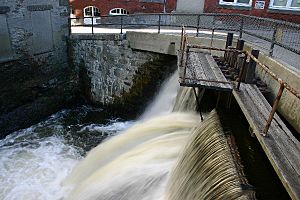American Printing Co. and Metacomet Mill facts for kids
Quick facts for kids |
|
|
American Printing Co. and Metacomet Mill
|
|

Metacomet Mill, built 1847
|
|
| Location | Anawan St., Fall River, Massachusetts |
|---|---|
| Area | 8.6 acres (3.5 ha) |
| Built | 1847 |
| Architect | Durfee, Bradford |
| Architectural style | various |
| MPS | Fall River MRA |
| NRHP reference No. | 83000617 |
| Added to NRHP | February 16, 1983 |
The Metacomet Mill and the American Printing Company Mill No. 7 are two important old buildings in Fall River, Massachusetts. The Metacomet Mill was built way back in 1847. It was made by Colonel Richard Borden to produce cotton cloth. It's the oldest textile mill still standing in Fall River!
Right next to it is the American Printing Company Mill No. 7. This one was built later, in 1906, also for making cotton fabric.
Both of these historic mills were added to the National Register of Historic Places in 1983. This means they are recognized as important historical sites. Today, many different small businesses use these buildings. In 1968, a photographer named Jack E. Boucher took pictures of the site for a special survey of historic buildings.
Contents
History of the Mills
Building the Metacomet Mill
The Metacomet Mill was first built in 1847. It was started by Colonel Richard Borden, a very important businessman in the area. He had already started the Fall River Iron Works in 1821.
The plans for the Metacomet Mill came all the way from Bolton, England. People thought it was a "model mill" because it was so well-designed for its time. The mill was built using local stones. It was placed right over the Quequechan River's stream. The flowing river helped power the machines inside the mill.
The Metacomet Mill was also special for another reason. It was the first time that strong cast iron beams were used to build a mill in the United States. Before this, people used wooden supports. But wood could get soft over time, making the floors sag. This would mess up how the machines worked. Cast iron was a much better and stronger choice!
Later Changes and New Mills
The Metacomet Mill was made much bigger later in the 1800s. A steam engine was also added to give it more power, especially when the river wasn't flowing strongly enough. It later became known as "Iron Works" Mill No. 6.
The American Printing Company Mill No. 7 was built in 1906. It was made of red brick. This mill was built just upstream from the Metacomet Mill. It was on the spot where another old mill, the Anawan Mill, once stood. Colonel Richard Borden had built that mill too, back in 1825.
Mill No. 7 was the last big building added by the American Printing Company. This company was once the biggest employer in Fall River. It was very important during the time when cotton textiles were a huge industry there. Mill No. 7 also had a cool Gothic-style engine house. You can still see it today along Anawan Street.
The Mills Today
Location and the River
The Metacomet Mill and American Printing Company Mill Number 7 are the only two mills left over the falls of the Quequechan River. This river used to have many mills along its steep path.
In the 1960s, a big highway, Interstate 195, was built around the mill complex. The ramps for the Braga Bridge also surround it. Even with the highway, you can still see the falls of the Quequechan River. The city of Fall River was actually named after these falls!
Two small dams are on either side of the Number 7 mill. They create small pools before the water flows under the mills. Most of the river was put into underground tunnels in the 1960s because of the highway construction. The river "daylights" (comes out into the open) at the far end of the Metacomet Mill's parking lot. This is under the Braga Bridge, next to the train tracks.
Current Use of the Buildings
Today, these two historic mills are home to many different small businesses. For example, there's a fitness center called W.O.W. One of the old brick smokestacks at the site even has a sign advertising the fitness center. The other smokestack holds equipment for mobile phone signals.
Because of the highway, the area around the mills feels a bit separate. It's like a hidden spot between downtown and the waterfront.





